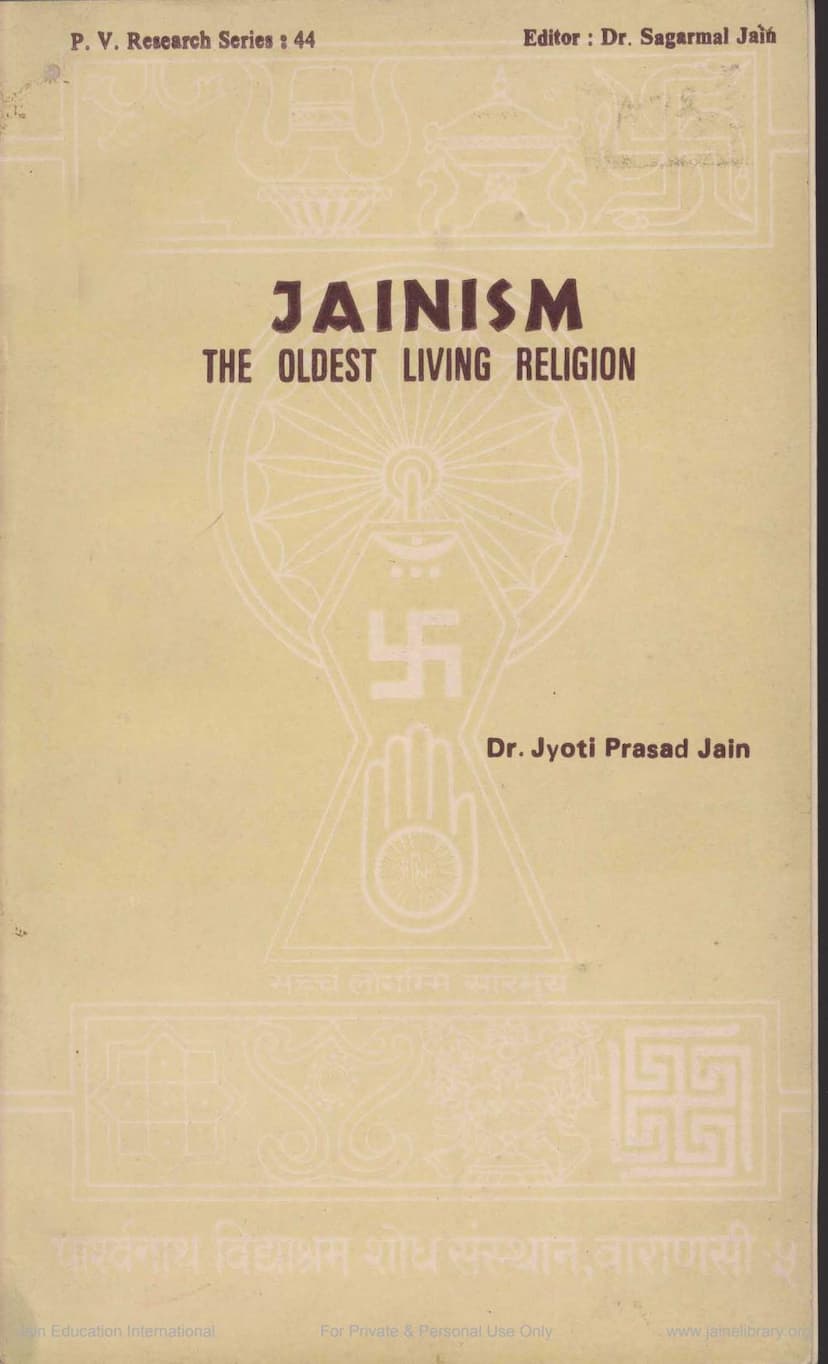Jainism The Oldest Living Religion
Added to library: September 2, 2025

Summary
Here's a comprehensive summary of the Jain text "Jainism the Oldest Living Religion" by Jyoti Prasad Jain, based on the provided pages:
The book, published by P. V. Research Institute, Varanasi, aims to prove that Jainism is the oldest and an independent religion of India, predating Vedic culture. The author, Jyoti Prasad Jain, argues against the common misconception that Jainism was founded by Lord Mahavira or Lord Parshvanatha, or that it was merely a revolt against Vedic culture.
The preface highlights that research on Indian thought and culture by European scholars in the last two centuries, often viewed through their own perspectives, has led to incomplete and unsystematic interpretations of India's religious and cultural history. This has resulted in historical works, taught in Indian educational institutions, misrepresenting Jainism's origins and independence.
Key arguments and evidence presented in the text to establish Jainism's antiquity and independence include:
-
Critique of Foreign Interpretations: The book criticizes the reliance on foreign accounts (Greek, Chinese, Arab, European travelers) for Indian history, noting their potential biases, lack of language proficiency, and limited understanding of Indian customs. These accounts were often prioritized over indigenous sources, leading to inaccuracies.
-
Refutation of Buddhist Derivation Theory: The text cites the work of Dr. Hermann Jacobi, who successfully refuted the theory that Jainism was a later derivation of Buddhism. Jacobi's research established that Mahavira was a contemporary and rival of Buddha, and that Jainism was already a firmly established religion before Buddha's time. Mahavira is presented as a reformer rather than a founder.
-
Buddhist Literature References: The book details how Buddhist scriptures themselves refer to Mahavira (as Nigantha Nataputta) and his teachings. These references often depict Jainism as a rival sect of long standing, implying its antiquity. They also highlight Mahavira's claims of omniscience and the belief in his disciples' future births. The text notes the schism among Mahavira's followers after his death, indicating a pre-established order.
-
Mutual Conversions and Influence: References to mutual conversions between Buddhist and Jain followers, as documented in Buddhist literature, are presented as evidence of their distinct existence and interaction. The text also suggests that Buddhism borrowed terms like "Asrava" and "Samvara" from Jainism, indicating an earlier origin for these concepts within Jainism.
-
References to Earlier Tirthankaras (Parshvanatha): The historicity of Lord Parshvanatha, the 23rd Tirthankara who preceded Mahavira by 250 years, is strongly supported. His existence is widely accepted by modern scholars, with his death placed in the 8th century B.C. This clearly establishes Jainism's lineage beyond Mahavira.
-
Evidence for even Earlier Tirthankaras (Neminatha, Rishabhadeva): The book delves into evidence suggesting the existence of Tirthankaras even before Parshvanatha, such as Neminatha (the 22nd Tirthankara) and Rishabhadeva (the first Tirthankara).
- Neminatha: His connection to Lord Krishna is discussed, with scriptural references in Vedas, Puranas, and even a Babylonian copper plate grant suggesting his worship existed well before Parshvanatha and Mahavira.
- Rishabhadeva (Adinatha): This first Tirthankara is presented as a significant figure who predates even Neminatha. The text points to:
- Mentions in the Yajurveda, Samaveda, and Rgveda (with commentators acknowledging the name "Rishabha" as a personal name).
- Endorsement by the Bhagavata Purana as the founder of Jainism and an avatar of Vishnu, preceding other avatars like Vamana, Rama, and Krishna.
- The tradition of his son Bharata, after whom India was named Bharatavarsha, indicating his ancient lineage.
- Potential connections to the prehistoric Indus Valley Civilization (Mohenjo-daro and Harappa), citing shared characteristics like nudity (of ascetics), yoga postures (Kayotsarga), and symbols like the bull (Rishabha's emblem).
-
Jainism and Pre-Aryan/Dravidian Civilization: The book links Jainism with the indigenous Dravidian people and the Indus Valley Civilization, suggesting that Jainism was the religion of these early inhabitants before the arrival of the Aryans and the evolution of Vedic religion. The Vratyas or Vṛṣalas mentioned in early Brahmanic literature are identified with these indigenous Jaina followers.
-
Jainism's Independent Philosophical and Doctrinal Identity: The text emphasizes the unique and distinct philosophical tenets of Jainism, such as its animistic beliefs, rejection of a creator God, subtle karma theory, and the concept of six eternal substances (Dravyas). These are presented as evidence of its originality and independence from Brahmanism and Buddhism.
-
References in Vedic and Puranic Literature: The book cites numerous references to Jainism, its Tirthankaras, and doctrines within Brahmanical literature, including the Vedas, Upanishads, Mahabharata, Ramayana, and Puranas. While some references are critical or misinterpretive, others praise Jainism, demonstrating its presence and influence during the Vedic period.
-
Jainism as the Basis, Not Offshoot: The author concludes that Jainism is not a daughter or rebellious child of Hinduism but rather the basis upon which ancient creeds, including Hinduism, were built. Any borrowing was likely the other way around.
In essence, "Jainism the Oldest Living Religion" presents a strong case for Jainism's profound antiquity and its status as a distinct, indigenous religion that predates and influenced many other Indian religious and philosophical systems, including those of the Vedic tradition. The book aims to correct historical misconceptions by drawing upon scriptural evidence, comparative studies, and archaeological findings.